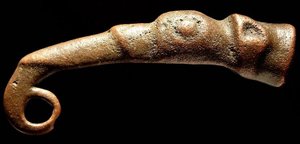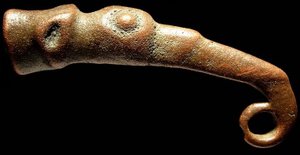Early medieval Irish drinking horn finial
This drinking horn final, or if one like 'terminal' I have addressed for the first time in this blog.
Having shown this drinking horn finial to James Graham Campbell, in the form and ornament he considered it of probably 8th century Irish origin. And not, like Dirk Kennis description of 'Anglo-Scandinavian 11th century'. He also pointed to me that Carol Neuman de Vegvar was in the process of compiling a catalogue of all such drinking-horn mounts and suggested that I contact her.
In the meantime the director of the National Museum of Ireland, Raghnall Ó Floinn expressed his opinion about this drinking horn finial as follow, after James showed him the finial via mail:
'I agree – there’s no reason to think that its anything other than Irish and probably of 8th century date. I’m not too familiar with the full range of examples - Carol would be - but there are a couple of interesting points about this one. Its abraded condition suggests it may have come from a river or coastal environment (sandhills?), and it’s probably been over-cleaned also. It looks fairly complete and it is odd that there is no means of fixing it to the horn – the fact that the socket is open at the end (if not a product of wear) would make it even more difficult to secure.
The overall appearance at first is of a bird-headed terminal with curled beak but it is clearly zoomorphic with something issuing from its mouth – is this just a tongue or could it be a bird head? The loop at the end means that it could have had a ring for suspension.
An interesting piece – pity there’s no real context!'
In reaction on Raghnall Ó Floinn's view, Carol Neuman de Vegvar responded as follows:
'Raghnall may be right about its Irish provenance, as the proportions of the head are very similar to the Moynaugh Lough example, as Thomas Kamphuis suggests.
However, another close parallel for the overall design, with an analogous cast curled beak/tongue forming a loop possibly for a suspension chain, is an Anglo-Saxon (?) terminal that came up as a metal detectorist find at Ormesby by St. Margaret with Scratby, Norfolk, and now part of the Norfolk Museums collections. In that case, however, the curl is more probably a raptor beak, although the terminal is, like the example before us, rather badly abraded, in the case of the Ormesby terminal to the point of obscuring details of the original design. Image of the Ormesby example, courtesy Tim Pestell at Norfolk Museums, attached.
The example from Katwijk Klein-Duin (Leiden, Rijksmuseum van Oudheden) has a similar loop but has a more symptomatically Anglo-Saxon eye surround, as does the example with partial loop from Loveden Hill (Lincoln, City & County Museum).
I would very much like to see Kamphuis's terminal when I'm across the pond later this summer; may I contact him directly?'.
So.. a visit from the other side of the ocean was arranged!
Before the visit, she gave me the following response:
I've been working on the drinking horns from the British Isles across the era from the departure of the Romans to the arrival of the Normans, including the ones that postdate the arrival of the Norse in England and Ireland, for quite a long time. So far I have published several articles on them and have another three articles currently in press( see attached list). The book itself is delayed by the demands of full-time teaching, but I hope to retire in a few years and then will have time to finish the project. The volume concerns both terminals and rim mounts. I would be delighted to add your example to the catalog there.
I would be very surprised if your example were Anglo-Scandinavian. The closest parallel is the Moynaugh Lough terminal, which is quite a lot earlier. The later Irish examples that postdate the strong Norse presence in Ireland tend to be covered with zoomorphic interlace of the period, and to have a flat base and a lateral curvature which suggests that they were intended to anchor a filled horn raised on legs.
The example from Holland to which I alluded was found in a cremation grave at Katwick-Klein Duin. It was published in an article by Jos Bazelmans, Menno Dyjstra and Jan de Koning, "Holland during the first millennium," in Bruc Ealles Well: Archaeological essays concerning the peoples of north-west Europe in the first millennium AD, ed. Marc Lodewijckx (Acta Archaeologica Lovaniensia, Monographiae 15), Leuven University Press, 2004, figure 8 on page 26. Like your example, it has the loop at the end of the bill or muzzle, but the beak is flat like the early Anglo-Saxon examples. It's thought to be from England.
The visit from Carol took place July 18th 2016 whereby she thoroughly examined the drinking horn finial. To register things as good as possible, I have filmed here findings. But as it was a sunny hot day and the windows where open, just at the moment I have filmed her, some pretty noisy cleaning machines picking up the dirt in the street passed by - very slowly.
So, here is the text integral written down, the recording I have attached beneath - having learnt me that the camera always should be hold horizontal, not vertically ;)
'Ok. So this is very probably late 8th early 9th century copper alloy, if I had to guess very probably from Ireland. Drinking horn fitting, the loop at the front end probably for a suspension chain, the laidback ears allong the collar suggest that this is not supposed to be a bird, as generally birds have not have such large ears, so more likely meant to be understood as a hound, perhaps. The opening at the bottom is something I have found in a number of Irish examples. It is all copper alloy, I do not see any traces of inlay or other applied decorations, so this is entirely one piece casted copper alloy. I'd say late 8th, some time in the 9th century perhaps, that is as close as I can come, looking at it. There is not trace of horn inside it, but the way that it is open at the bottom suggests and the end that it was mounted or intended to be. Very possibly. It is not the most elaborate example I have seen, but it is a very solid example and the weight is also impressive. It is a very solid and constructive piece of work and in rather nice condition altough some surface abbration. That is pretty much what I've got!'
In my forementioned blog I have forgot to give the measurements of the drinking horn finial, these are:
90 mm (9 centimeters) in a diagonal line from top to tip of the snout
19 mm at broadest point of the socket
4 mm at the beginning of the curling part of the snout
Seen from above:
at its broadest point: 15 mm
at its narrowst point: 3 mm
Well. I could have been with these stones until after dark, but as my wife wanted to travel on.. well.. I see you again, some day, hogback stones from Gosforth. And if you happen to be there one day, do not forget that monument on the outside...
Further on with the Cumbrian hogbacktour !
In - yes, luckily again in - St. Peter's church in Heysham, there is a truly beautiful hogback stone. The guide told us, it had been studyied by Thor Ewing, a writer, in 2000. in 'Understanding the Heysham hogback' A tenth century sculpted stone monument and its context (link), Thor Ewing tells in detail what he dicovered on the both sides of this hogback stone.
Just being brought in the church as late as the 1970's accompanied with some protest here and there among the church visitors, considered as being a token of old paganism, it had been remarkably nice preserved, and a lot of detail can be seen, still. Truly worthwile a visit.
I had a small debate with the guide in the church if the - zoomorphic, in my opinion - faces on the sides were lions (or hippo's). The guide doubted if the vikings could have known about lions. Well I guess so, concerning the runes on the Ancient Greek lion statue at the Arsenal, Venice. For example. Vikings did travel south..
But when he told me he was doubting the vikings 'discovered' (as the native inhabitants were of course, in the first place) America before Columbus, I decided to rest my case..
One has to know when to start and to end a conversation ..
Just discovered the book in a bookstore written by Geoff Holder - The guide to the mysterious Lake District, I knew there had to be another hogback stone in Lowther, St. Micheal's Church. With a promising image described in the text of 'a naval and a land-based force of shield-bearing vikings above a fish and what might be a coiled sea serpent. On the reverse is a row of female figures with snakes, possibly a representation of the hideous hag Hel'. Wow. If that did not sound as a true pagan promised land ..
Not complaing too much after all we have seen, this visit was the dissapointing one of them all. But if you wife states 'I am happy to have seen them' and I am answering 'Measuring is knowing' and the even more obligate verb 'handling 'if we did not see it at all, we wouldn't have known anything at all of how they were looking' the glass was again half full, at the last day of our journey..
The hogback stone appeared to be just being tolerated within the entrance segment part of the church. As something you never use anymore but you do not throw away - entirely. That sort of feeling emerged when seeing this hogback asylum seekers.. Bed, bath and bread, ás we say in Dutch, but no luxury at all and standing on some outcuts of wood, you would balance the table with at home..
Come on, St. Micheal's Church.. care a bit more of your 'children' !
This hogback stone was moved in the church in 1907. Hogback stones layed partially buried in the churchyard before it was dug up and moved into the church.
The promising depiction of a longship - as certainly can be seen after some studying - see http://vikingminds.co.uk/pages/longship
we have missed !
The stone itself is (157 x 50 x 30 cm) and very worn.
The hogback stones in Cumbria - very diverse in quality, but everyone worth a visit ! Especially on a gloomy day in late October ...
The churches to visit - see photos of resp. St. Andrew's church in Penrith, St. Mary's church in Gosforth, St. Peter's church in Heysham and St. Micheal's church in Lowther.
Did I miss out on another one in Cumbria ? Let me know !
In a next blog I will take you to four - still remaining utterly mysterious- statues 'guarding' the graveyard of St. Andrew's church in Dacre..
For the last blog of October 9th see this link.
References: (as always, links to where the books can be ordered are attached).
Edwards, B.J.N. Vikings in North West England - The artifacts (1998);
Emery, Gordon, CURIOUS CUMBRIA, The Lake District & Beyond: A celebration of Cumbria (2023)
Ewing, T. 'Understanding the Heysham hogback' A tenth century sculpted stone monument and its context ;
Hall, R. Viking Age archaeology in Britain and Ireland (first printed 1990, reprinted with amendments in 1995);
Holder, G. The guide to the mysterious Lake District (2009)
possibly also (as there within the part of Cumbria dealing with Carlisle, the Eden Valley, Barrow-in-Furness, Whitehaven and the west coast is being dealed with)
Holder, G. Paranormal Cumbria (2010)
http://vikingminds.co.uk/pages/longship

